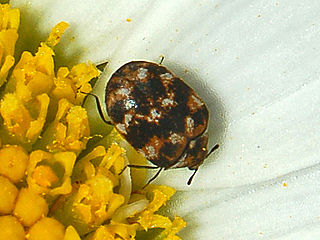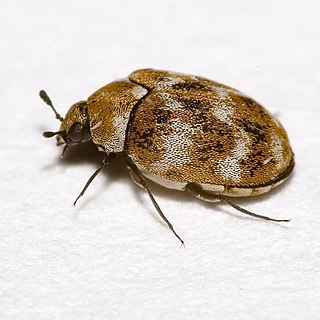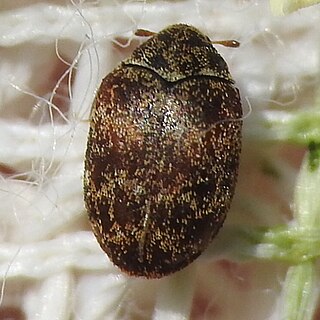
Dermestidae are a family of Coleoptera that are commonly referred to as skin beetles. Other common names include larder beetle, hide or leather beetles, carpet beetles, and khapra beetles. There are over 1,800 species described.

The varied carpet beetle is a 3 mm-long beetle belonging to the family Dermestidae, positioned in subgenus Nathrenus. They are a common species, often considered a pest of domestic houses and, particularly, natural history museums, where the larvae may damage natural fibers and can damage carpets, furniture, clothing, and insect collections. A. verbasci was also the first insect to be shown to have an annual behavioral rhythm and to date remains a classic example of circannual cycles in animals.

Anthrenus is a genus of beetles in the family Dermestidae, the skin beetles. One of several genera of carpet beetles, Anthrenus was historically placed in a subfamily Anthreninae, though presently included in the Megatominae. The genus Neoanthrenus is closely related.

Megatominae is a subfamily of the beetle family Dermestidae. This subfamily contains several of the most well-known household and stored-product pest beetles, in the genera Anthrenus and Trogoderma.

Anthrenini is a tribe of beetles in the family Dermestidae. There are at least 100 described species in Anthrenini.

Anthrenus castaneae is a species of carpet beetle in the family Dermestidae. It is found in North America.

Anthrenus thoracicus is a species of carpet beetle in the family Dermestidae. It is found in North America.

Anthrenus lepidus is a species of carpet beetle in the family Dermestidae. It is found in North America.
Orphilus subnitidus is a species of carpet beetle in the family Dermestidae. It is found in North America.
Dearthrus is a genus of carpet beetles in the family Dermestidae. There are at least two described species in Dearthrus.
Anthrenus maculatus is a species of carpet beetle in the family Dermestidae. It is found in North America.

Anthrenus sophonisba is a species of carpet beetle in the family Dermestidae. It is found in North America.

Attagenus fasciatus, known generally as banded black carpet beetle, is a species of carpet beetle in the family Dermestidae. Other common names include the tobacco seed beetle and wardrobe beetle. It is found in North America, Oceania, and Europe. Attagenus fasciatus is nearly a cosmopolitan species and widespread throughout the tropical and subtropical regions of the world.

Anthrenus (Anthrenus) oceanicus, is a species of skin beetle native to Hawaii, India, China, Indonesia, Sri Lanka, New Caledonia and Mauritius. It is introduced to Egypt, French Polynesia, Czech Republic and England particularly with commodities.

Anthrenops is a subgenus of the genus Anthrenus of the subfamily Megatominae within the family of skin beetles. Subgenus is distinguished by antennae with 9 segments.
Ranthenus is a subgenus of the genus Anthrenus of the subfamily Megatominae within the family of skin beetles. Species of subgenus are present only in Asia and Turkey. Subgenus is distinguished by antennae with 4 segments.

Helocerus is a subgenus of the genus Anthrenus of the subfamily Megatominae within the family of skin beetles. Subgenus is distinguished by antennae with 5 segments.

Solskinus is a subgenus of the genus Anthrenus of the subfamily Megatominae within the family of skin beetles. Subgenus is distinguished by antennae with 7 segments.

Anthrenus is a subgenus of the genus Anthrenus of the subfamily Megatominae within the family of skin beetles.

Anthrenus pimpinellae complex is a group of closely related species from subgenus Anthrenus. Most species that currently belong to the group were previously assigned as subspecies of Anthrenus pimpinellae.















